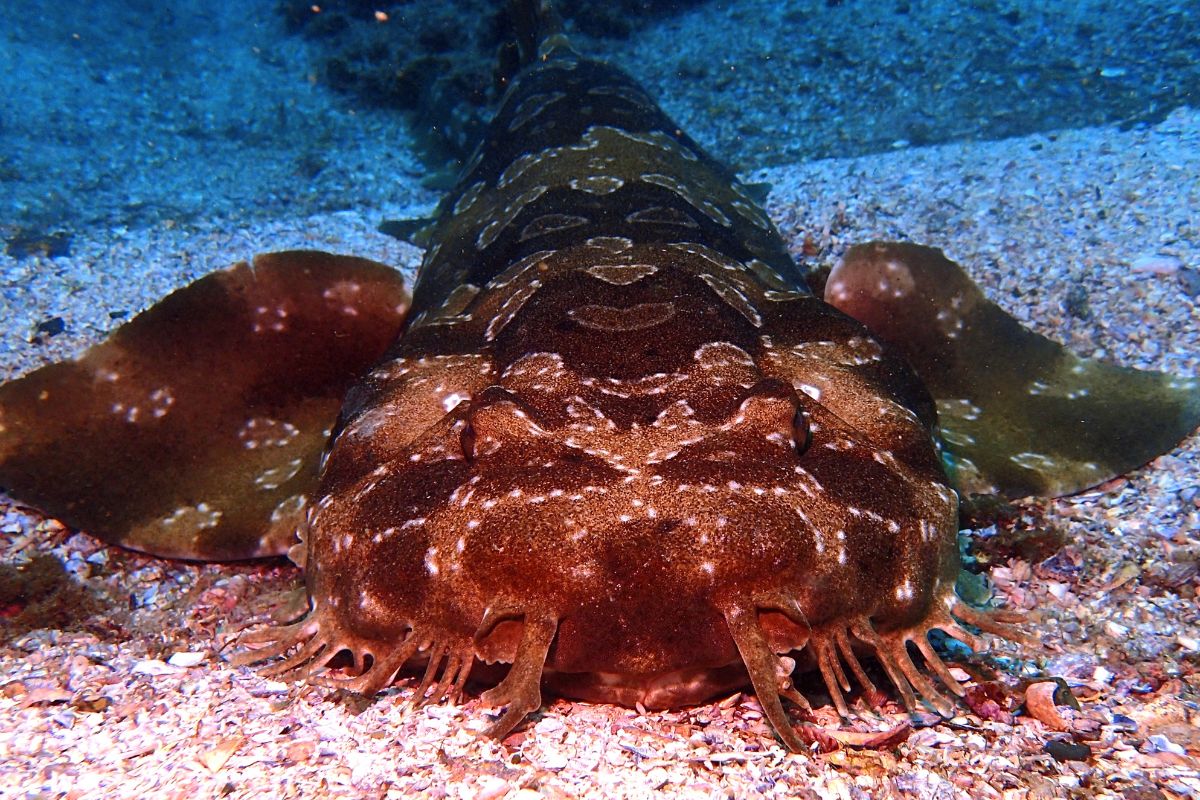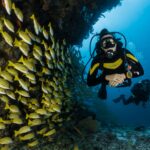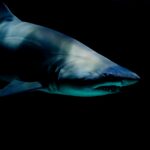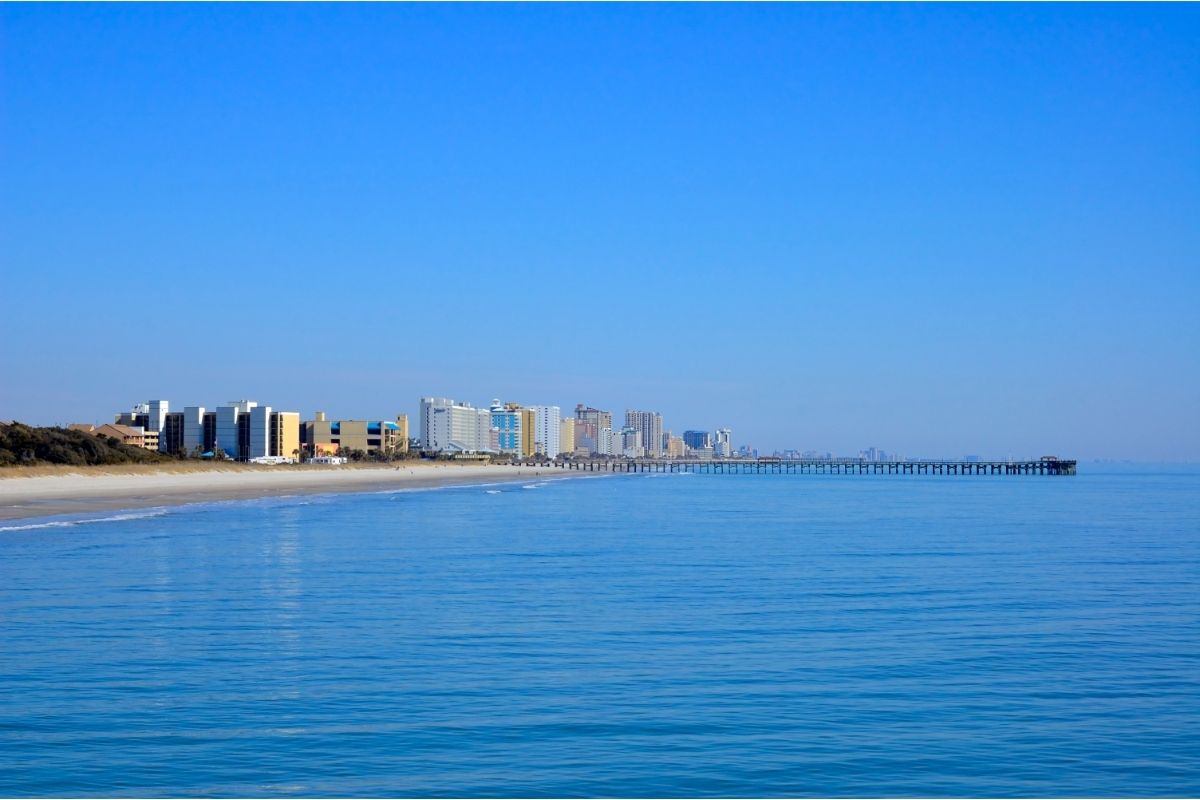What Is A Wobbegong Shark?
There are 12 different species which make up the group which is specified as Wobbegong sharks and this tends to include the carpet sharks which are in the Orectolobidae family.
The name of this group of sharks, Wobbegong is thought to have come from the Aboriginal phrase in Australia which roughly translates into ‘shaggy heard’ which is in reference to its extended growth which is surrounding the mouth of this type of shark.

Where Are Wobbegong Sharks?
Wobbegong sharks are usually going to be found natively in areas surrounding Australia as well as Indonesia.
These sharks are known to prefer the shallow temperate and tropical waters which are found in the West Pacific and the East Indian Ocean.
The exception to this is 1 of the 12 species of Wobbegong shark which is recognized to have come from the much more Northern Japan that is called Orectolobus japonicus, but more commonly known as the Japanese wobbegong.
Description Of Wobbegong Sharks?
Appearance Of Wobbegong Sharks
A defining trait of a Wobbegong shark’s appearance is that they tend to have bold type markings which appear on its body which will appear in a pattern which is symmetrical which can be easily compared to a carpet.
This is why, as mentioned in the introduction, these sharks are classified as carpet sharks. The markings which are characteristic of Wobbegong sharks are also what makes them so good at camouflaging themselves.
Another defining aspect of Wobbegong sharks is their beard which are actually more akin to very small whiskers which occasionally resemble weeds.
This beard of the Wobbegong will usually surround their jaw. One of the main functions of a Wobbegong shark’s beard is that they act like sensory bards as well as completing the appearance and illusion of their camouflage.
Wobbegong sharks also have small teeth in comparison to some other sharks, however these teeth are still quite large and if bitten, other fish and humans can sustain some serious injuries.
Growth Size Of Wobbegong Sharks
On average, most types of Wobbegong sharks will grow to about 49.2 inches or 125 cm, in spite of this, there are larger Wobbegong sharks which can get to a massive 117.6 inches, or 300 cm.
The larger Wobbegong sharks are called banded wobbegongs, or Orectolobus halei, as well as the spotted wobbegong or Orectolobus macalatus.
Behavior Of Wobbegong Sharks
Generally speaking, Wobbegong sharks will tend to prefer lying low in the bottom of the places in which they dwell and tend to be much less active than other swimming sharks.
Because of this, a typical Wobbegong will spend most of its life resting on the seafloor.
On top of this, most Wobbegong sharks are nocturnal for the most part meaning they are much more active when it is dark than when it is light.
In spite of this, Wobbegong sharks can be quite aggressive likely to attack something if it gets too near them, because of this, other marine species tend to avoid them meaning they can remain resting in their dwelling.
If something is bitten by a Wobbegong, however, these sharks tend to hand on once they have bitten something and can often be quite hard to detach.
For the most part, this shark species hides within rocky environments.
Feeding Wobbegong Sharks
Wobbegong sharks can be classified as opportunistic predators which ambush their prey.
The prey which a Wobbegong shark goes for is one which has not noticed its presence and has gotten far too close to where it is resting and hiding.
For the most part, and being bottom dwellers, these sharks feed mostly on more small fish.
Wobbegong Sharks In The Wild And Humans
It has been recorded on multiple occasions that Wobbegong sharks have attacked divers, swimmers, snorkelers and surfers, especially in cases where these individuals will have gotten too close to where the Wobbegong sharks rest.
However, this is not the only case, and Wobbegong sharks have even been recorded to attack humans when unprovoked, but luckily none of these incidents have ever ended up being fatal.
The Economic Value Of Wobbegong Sharks
As well as their use within the aquarium trade and the value Wobbegong sharks have in this, the skin of a Wobbegong shark is also used by some to be turned into leather.
Their flesh is also occasionally used in fish and chips in some areas and in the cases when the shark flesh is eaten, this kind of meat will be referred to as flake.
The 12 Different Species Of Wobbegong Sharks
As previously mentioned, there are 12 currently known different species of Wobbegong sharks, and these 12 species can fit in 3 different genera which are listed below.
Genus Orectolobus
This is the genus which 10 of the 12 Wobbegong sharks species are part of and these are:
- Orectolobus floridus – the Floral banded wobbegong
- Orectolobus halei – the Banded wobbegong or Gulf wobbegong
- Orectolobus hutchinsi – the Western wobbegong
- Orectolobus japonicus – the Japanese wobbegong
- Orectolobus leptolineatus – the Indonesian wobbegong
- Orectolobus maculatus – the Spotted wobbegong
- Orectolobus ornatus – the Ornate wobbegong
- Orectolobus parvimaculatus – the Dwarf spotted wobbegong
- Orectolobus reticulatus – the Network wobbegong
- Orectolobus wardi – the Northern wobbegong
Genus Eucrossorhinus
- Eucrossorhinus dasypogon – the Tasselled wobbegong
Genus Sutorectus
- Sutorectus tentaculus – the Cobbler wobbegong
The Wobbegong Shark As A Pet In An Aquarium
There are only really 2 different species of Wobbegong sharks which are an appropriate size to be in a home aquarium and these the Tasseled Wobbegong and Ward’s Wobbegong.
This is because these 2 types of Wobbegong are the smallest in size as well as being relatively sluggish in their behavior making them the best fit for an aquarium.
Just because these are the most appropriate Wobbegong sharks to have in home aquariums, does not mean that they are the only ones which feature in the aquarium trade.
There are of course larger varieties of Wobbegong which are occasionally on the market, but of course these are more difficult to care for.
All Wobbegong sharks, no matter their size, will at least attempt to prey on any tank mates, so they are not great for this kind of tank.
Also, the main reason they are not that popular as aquarium sharks is because they are just much less active than other sharks which are often more entertaining.
They are relatively low maintenance to care for having a slower than average metabolism and will not need to be fed frequently because of this with two times a week fitting them usually.
However, if they are underfed their dorsal musculature will become atrophied and this is a sign they will need to be fed more.
The Tasseled Wobbegong (Eucrossorhinus Dasypogon)
This section of the guide will focus on the Tasseled Wobbegong specifically due to its popularity within the aquarium trade and will discuss details about this species which are relevant if you plan to keep it as a pet in an aquarium.
First let’s look at the taxonomy of the Tasseled Wobbegong.
Taxonomy Of The Tasseled Wobbegong
- Kingdom – Animalia
- Phylum – Chordata
- Class – Chondrichthyes
- Order – Orectolobiformes
- Family – Orectolobidae
- Genus – Eucrossorhinus
- Species – E. dasypogon
- Binomial Nomenclature – Eucrossorhinus dasypogon
The first major recorded description of the tasseled wobbegong was made in 1867 by Dutch ichthyologist Pieter Bleeker where he based the description off 2 particular specimens which were found in Indonesia from Aru and Waigeo specifically.
Pieter proceeded to describe the shark as a dasypogon which was based off the Greek word for hairy being dasy and the word for beard being pogon.
He also classified the species in the genus of Crossorhinus which is now just synonymous with Orectolobus which is used more commonly nowadays.
Charles Tate Regan, instead formed his own new genus for the tasseled wobbegong calling it the Eucrossohinus from the Greek phrases eu being good, krossoi being tassel, and rhinos being nose.
Regan actually separated Eucrossorhinus away from Orectolobus originally due to the difference in spacing the species had between its 4th and 5th gill slits, but then he reconsidered making the 2 terms the same.
Because of this, the Wobbegong is now classified in its own genus or as Orectolobus.

Description Of The Tasseled Wobbegong
While the Tasseled Wobbegong is the term most commonly used to refer to this species, there are other ways in which this specific species is referred to like Ogilby’s Wobbegong as well as the Bearded Wobbegong.
This is also the only shark species which fits in the genus Eucrossorhinus and is within the group of carpet sharks and is in the Orectolobidae family.
This species is most commonly found within shallow reefs in New Guinea as well as in north Australia and islands which are close to it. The species has a flat and wide body which grows up to 49 inches or 124 cm.
The trait which makes this species the most different from its counterparts is its branching dermal lobes which go surrounding its head and extend towards its chin.
The tasseled Wobbegong is also able to camouflage itself because of its unique color pattern as well as the blotchy and crisscrossing line pattern. This helps it blend in with reef structure specifically.
For the most part, during the day this species will hide inside caves or if this is not possible, under ledges and will curl its tail.
These species also tend to have a preferred spot to rest in which is also where it will usually ambush any other fish in its range.
Occasionally this species of shark will be able to wave its tail to mimic the movement of a smaller fish in the effort to lure in more prey.
As previously mentioned, the Tasseled Wobbegong becomes much more active during the night and this is when they are much more likely to actively look and hunt for food.
Conservation Of The Tasseled Wobbegong
The Internation Union for Conservation of Nature (or IUCN) have listed Tasseled Wobbegongs as a species of Least Concern and the only causes of threat to this particular species are in the form of its habitat degradation as well as overfishing.
This is much more of a problem outside of Australia for these Wobbegongs.
The Characteristics Of The Tasseled Wobbegong
The Body Of The Tasseled Wobbegong
As has been mentioned, the body of a Tasseled Wobbegong is characteristically wide as well as flat with its head even being wide when compared to its length.
What has also been mentioned is its complex and unique color combination with the dorsal side of this shark often being compared to a mosaic.
Its patterning often has lots of dark and small blotches as well as lines with darker bands occasionally too. The base color for this species will usually be somewhere between a yellow-brow or a gray color.
This pattern also carries onto its tail underside as well as even been seen in the margins between the pelvic as well as the ventral pectoral fin. On top of this, the ventral side of this shark will also be white.
The Snout Of The Tasseled Wobbegong
The snout has unique branching lobes with the fringe lobes running from the tip of its stout up to the start of its pectoral fins.
On its chin it has its distinctive beard which is the reason for its other name as the Bearded Wobbegong.
And then near its nostrils this species has barbels which are sensory organs similar to whiskers which are branching and long.
This species also has grooves which are surrounding its nostrils which connect them into its mouth. The median portion of its lower jaw is also furrowed and these extend from the corner of its mouth.
The Eyes Of The Tasseled Wobbegong
The Tasseled Wobbegong also has tubercles located above its eyes which are not present anywhere else on it and behind its eyes it has large spiracles.
The eyes of Tasseled Wobbegongs are almost where its head ends with the eyes recessed from where the mouth starts.
The Teeth Of The Tasseled Wobbegong
On average the Tasseled Wobbegong has about between 23 and 26 upper teeth rows with the lower having around 19.
Each of these teeth has a slender cusp which points in each of the teeth. 2 of the lower rows and 3 of the upper are symphysical teeth which appear to look like longer fangs.
The Gill Slits Of The Tasseled Wobbegong
This species of Wobbegong usually has 5 pairs of shorter gill slits.
The Fins Of The Tasseled Wobbegong
As mentioned, the Tasseled Wobbegong has characteristically larger and rounder pelvic and pectoral fins with its dorsal fins having a short base which is tall in how it looks with the first one looking particularly larger in comparison.
After the shark’s pelvic fin, the body tapers until it reaches the caudal peduncle. It also has an anal fin which will grow to about half of its size and will originate just after the middle of the latter dorsal fin.
It has a short caudal fin too which only has an upper lobe which has a ventral notch located near its tip.
Survival Adaptions Of The Tasseled Wobbegong
As can be gathered, the Tasseled Wobbegong is a particularly solitary species and spends most of its days resting in what is usually its favored resting spot.
It swims quite slowly when it has to move and due to its complex coloration it often doesn’t have to due to its camouflage abilities.
Feeding Adaptions Of The Tasseled Wobbegong
The Tasseled Wobbegong’s mouth is incredibly capacious letting it swallow its prey whole and feeds as an opportunistic ambush on its prey.

It also actively participates in luring waving its tail to lure in other fish due to the shape of its caudal fin. It rests by elevating its head, so it has an attack advantage over any prey it has lured.
Food Materials Of The Tasseled Wobbegong
This species mostly feeds on cartilaginous and bony fish as well as crustaceans and cephalopods. It also eats schooling nocturnal fishes which may take shelter in the same cave in which a tasseled Wobbegong is resting in.
Parasites And The Tasseled Wobbegong
The most common parasite for a Tasseled Wobbegong is a tapeworm called Parachistianella monomegacantha which is attended to by the cleaner shrimp as well as the Bluestreak cleaner wrasse.
Reproduction Of The Tasseled Wobbegong
This species is classified as aplacental viviparous which means they give birth to their spawn while they are alive with embryos inside females sustained on yolk.
They mate by the male inserting claspers into the female’s cloaca and releasing sperm to fertilize eggs. When born the juvenile sharks are around 7.9 inches or 20 cm.
Tasseled Wobbegongs With Humans
These are some of the more aggressive of Wobbegongs and have attacked humans unprovoked before. They have poor vision and will attack anything which they could mistake for prey in its range.
This is the most common Wobbegong to find in the aquarium trade too.
Aquarium Care For The Tasseled Wobbegong
They grow up to 49 inches or 124 cm and because of this need a 135 gallon or 510 liter tank minimum. They are not a community shark with any tank mate being threatened.
The optimal temperature for the tank is between 72 and 82 Fahrenheit with 8,1 to 8,4 pH and marine saltwater.
Aquarium Decor For The Tasseled Wobbegong
To make the shark feel comfortable you should add ledges and caves for shade and a feeling of safety. Of course use correct aquarium plants as well as checking that the reef structure will be solid enough that it will not collapse.
Feeding The Tasseled Wobbegong
Feed your Wobbegong appropriate cephalopods and crustaceans or something like sweepers, soldier fishes or squirrel fishes. They only need feeding twice a week because of their metabolism.
Caution For The Tasseled Wobbegong
As mentioned, they are aggressive so be extra cautious and do not feed directly with the hand using a long stick instead.
Northern Wobbegong (Orectolobus wardi)
This is a different species of Wobbegong which can be kept within captivity successfully and in nature will usually be found either around Australia or the Pacific Ocean.
It will grow up to 30 inches and needs 135 gallons of tank space. Otherwise, it can be cared for relatively similar to its Tasseled variety.
Conservation
It is also at least concern by the IUCN and has less economic value but can still have its skin used for leather.
Japanese Wobbegong (Orectolobus Japonicus)
This is a different popular style of Wobbegong perhaps due to how odd it is in comparison to others of its family.
As the name suggests this species can be found in Japan but also around the Northwest Pacific as well as Korea and China. Similar to other Wobbegongs they are bottom dwellers.
This particular type of Wobbegong is a weak swimmer but instead prefer using paired fins to walk along their habitat to maybe get to a tidal pool.
Captivity Of Japanese Wobbegongs
These wobbegongs have not been successfully bred in a home aquarium, but this has been achieved in a public aquarium.
Conservation
The life history and population of this species is much less well known with the IUCN listed the species as Data Deficient, but they are also caught for food and have their skin used for leather.
Takeaway
Hopefully this guide has given you all the information you need to either feel informed on Wobbegongs to the extent you wanted to, or have all the information you need to look after one yourself.
Looking after a Wobbegong in a home aquarium is definitely an undertaking due to the effort and the space they need as well as the caution needed to deal with them without getting bitten, and if you want an active aquarium dweller, this is not the species to choose with it being nocturnal and resting during most of its waking hours anyway.
Also remember to not give this species any tank mates as they will feel threatened.
- Is It Possible For A Shark To Swim Backwards? - August 2, 2022
- Are Leopard Sharks Dangerous? - August 2, 2022
- What Are The Differences Between Shark And Dolphin Fins? - August 1, 2022








